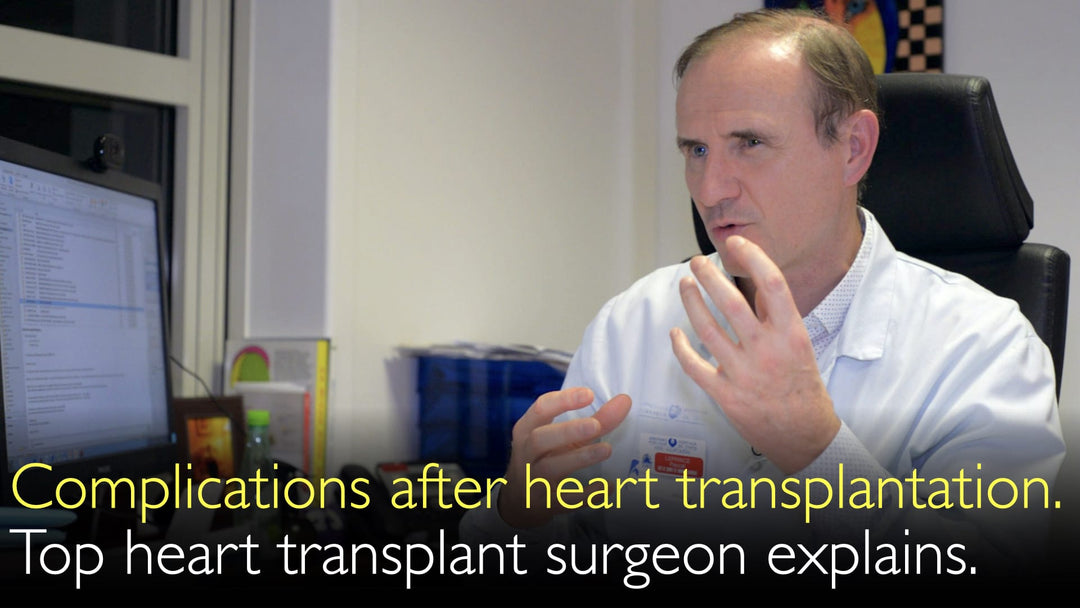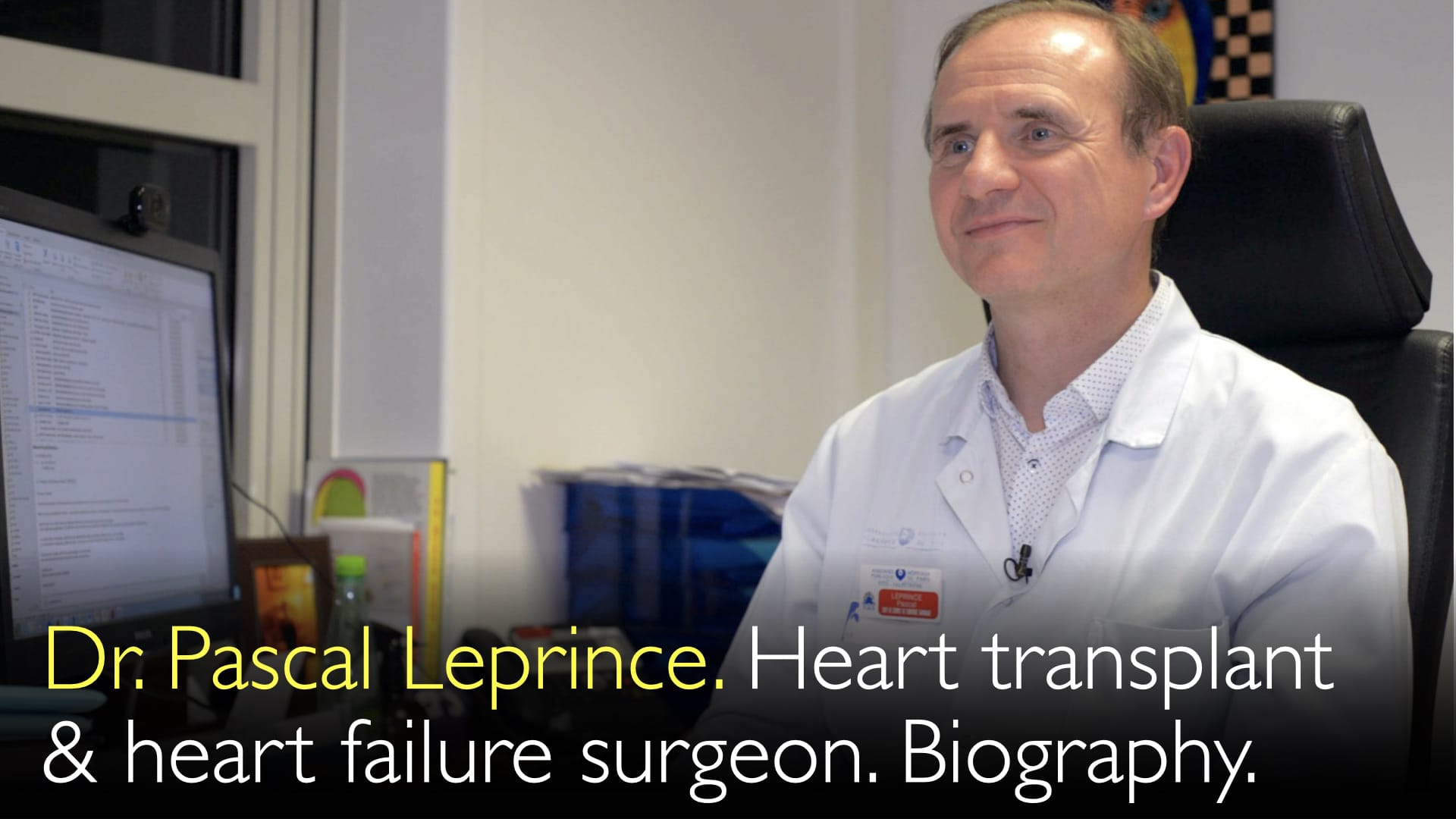מומחה מוביל בהשתלות לב, ד"ר פסקל לפרינס, MD, מסביר את הסיבוכים העיקריים לאחר השתלת לב, תוך התמקדות בתפקוד לקוי ראשוני של השתל. הוא מפרט כיצד גיל התורם ומצב המקבל משפיעים משמעותית על הסיכון לכישלון השתל, ודן בשימוש הקריטי בתמיכה מכנית לסירקולציה כמו ECMO כדי לסייע ללב החדש להתאושש.
הבנה וטיפול בתפקוד לקוי ראשוני של השתל לאחר השתלת לב
קפיצה לפרק
- סקירת סיבוכים לאחר השתלת לב
- מהו תפקוד לקוי ראשוני של השתל?
- גורמים תורם-תלויי: גיל וסיבת המוות
- גורמים מושתל-תלויי והשפעת ECMO
- טיפול בתפקוד לקוי של השתל באמצעות תמיכה מכנית
- תמליל מלא
סקירת סיבוכים לאחר השתלת לב
ד"ר פסקל לפרינס, MD, מנתח השתלות לב מוביל, מסווג את הסיבוכים שלאחר ההשתלה לשלושה סוגים עיקריים. הקטגוריה הראשונה כוללת סיכונים כירורגיים כלליים המשותפים להליכים קרדיאליים מרכזיים רבים. אלה כוללים דימום, הנושא סיכון גבוה יותר אם המטופל עבר ניתוחי חזה קודמים, והפרעות קצב לב. סיבוך כירורגי נדיר אך חמור הוא אירוע מוחי, או שבץ.
מהו תפקוד לקוי ראשוני של השתל?
סיבוך ייחודי וקריטי הספציפי להשתלת לב הוא תפקוד לקוי ראשוני של השתל. ד"ר פסקל לפרינס, MD, מתאר זאת ככישלון של הלב החדש לתפקד כראוי מיד לאחר הניתוח. זה מתרחש במהלך תהליך הגמילה של המטופל ממכונת העקפת ריאות-לב, הדורשת שתל מתפקד היטב. שכיחות סיבוך זה משתנה מאוד, בין 5% ל-25%, ומושפעת מאוד ממומחיות צוות הכירורגיה.
תפקוד לקוי ראשוני של השתל נע בחומרתו. מקרים קלים יותר עשויים לדרוש רק תרופות תוך-ורידיות זמניות לתמיכה בהתכווצות הלב. מקרים חמורים יותר מצריכים תמיכה מכנית ממושכת במחזור הדם כדי לשמור על יציבות המטופל בזמן שהלב החדש מחלים.
גורמים תורם-תלויי: גיל וסיבת המוות
מאפייני תורם הלב הם גורם מרכזי בקביעת הסיכון לתפקוד לקוי ראשוני של השתל. ד"ר פסקל לפרינס, MD, מדגיש הבדל בינלאומי משמעותי: גיל התורם הממוצע בצרפת הוא 44, לעומת 33 בארצות הברית. פער גילים זה имеет השלכות עמוקות מכיוון שתורמים מבוגרים יותר often have different causes of death, primarily stroke.
ד"ר פסקל לפרינס, MD, מסביר שמוות תורם משבץ מצביע על בעיות כלי דם בסיסיות, כולל פוטנציאל לטרשת עורקים, או רובד כולסטרול, בעורקי הלב עצמו. זה יכול לפגוע באיכות השתל. לעומת זאת, תורמים צעירים יותר often die from trauma like car accidents or gunshot wounds, which may not directly affect heart tissue quality.
גורמים מושתל-תלויי והשפעת ECMO
באופן מדהים, מצבו של מושתל ההשתלה הוא גם סיבה ישירה לתפקוד לקוי של השתל. ד"ר פסקל לפרינס, MD, מציין שרבים מהמושתלים נמצאים במצב קריטי לפני הניתוח, often spending over two weeks in the ICU, intubated, and with renal dysfunction. חלק גדול, close to 50% in his experience, are stabilized on ECMO (Extracorporeal Membrane Oxygenation) before transplantation.
ד"ר פסקל לפרינס, MD, שיתף פעולה עם חוקרים מאוניברסיטת קולומביה כדי לחקור תופעה זו. המחקר המעבדתי שלהם הדגים שהנסיוב ממטופלים under ECMO before transplantation can directly induce dysfunction in cardiac cells. ממצא זה מאשר שמצבו הפיזיולוגי הדלקתי והמתוח מאוד של המושתל הוא תוקף עצמאי ללב המושתל השביר.
טיפול בתפקוד לקוי של השתל באמצעות תמיכה מכנית
בהתחשב בשכיחות הגבוהה של מושתלים חולים ובשימוש בתורמים מבוגרים יותר, הטיפול בתפקוד לקוי ראשוני של השתל הפך לחלק מרכזי בטיפול השתלתי מודרני. ד"ר פסקל לפרינס, MD, מציין שצוותו משתמש באופן יזום ב-ECMO לאחר ההשתלה כמערכת תמיכה מכנית במחזור הדם. מכשיר זה מסייע במחזור הדם של המטופל, ומספק זמן ותמיכה חיוניים להחלמת שתל הלב החדש מהלחץ העצום של ההשתלה.
גישה זו היא תגובה ישירה לאינטראקציה המורכבת של גורמי תורם ומושתל המובילים לכישלון השתל. על ידי ציפייה לצורך בתמיכה, ד"ר פסקל לפרינס, MD, ועמיתיו שואפים לשפר תוצאות במקרי ההשתלה המאתגרים ביותר.
תמליל מלא
ד"ר אנטון טיטוב, MD: אתה מנתח השתלות לב מוביל. אילו תופעות לוואי וסיבוכים אתה רואה לאחר השתלת לב?
ד"ר אנטון טיטוב, MD: אתה שותף לכתיבת ההנחיות הבינלאומיות על בעיות בלב מושתל.
ד"ר פסקל לפרינס, MD: ישנם שלושה סוגים של סיבוכים לאחר השתלת לב. הסיבוך הראשון קשור לניתוח הכירורגי. אנו יכולים להתמודד עם אותם סיבוכים כמו בניתוח רגיל, למשל, בניתוח מעקפים כליליים. סיבוך זה הוא דימום. לפעמים המטופל כבר עבר many operations before, then the risk of bleeding is higher.
סיבוכים אחרים could be cardiac arrhythmias and CVA, cerebrovascular accident. שבץ הוא סיבוך בסיכון נמוך, אך הוא יכול לקרות.
אבל there is one complication after heart transplantation. This side effect is not common with other diseases. It is heart graft failure. The primary heart graft failure in some newly transplanted patients happens right after the surgery.
מטופל נמצא על עקיפת ריאות-לב during cardiac transplantation surgery. Then the heart restarts as soon as the blood is going through the coronary artery of the graft. הלב simply resumes beating. Then you start to wean the cardiopulmonary bypass off.
But to wean the patient off cardiopulmonary bypass, you need to have a well-functioning graft, the new heart. Once in a while, you have a problem. It is not so rare because it depends on surgical team quality. It is like somewhere between 5% to 25%.
ד"ר אנטון טיטוב, MD: You can face dysfunction of the new heart graft. It means the new heart graft at least will require some intravenous drips to get better heart contraction. This is okay. Sometimes a patient just requires intravenous drip with medications for a few days. I would say it is not a huge heart dysfunction.
But some patients with heart graft failure you have to keep on mechanical circulatory support. The primary heart graft dysfunction means that it is not due to another complication. That is just the heart graft that does not work well by itself.
This is interesting. Primary heart graft dysfunction can be related, of course, to the heart graft itself. Complication after heart transplantation can be related to the donor's heart. People have to understand that, for instance, in France, the mean age of the cardiac donor is 44. In comparison, in the United States, the mean age of the cardiac donor is 33. This makes a huge difference.
Because we know that with an older donor, the rate of primary heart graft failure is higher. It is so not only because heart donors in France are older, but because the cause of death for older heart donors is different in comparison to the cause of death of younger heart donors.
Sometimes you have a young heart donor. The main cause of death is gunshot or stab wound, or car accidents. On the other hand, it is suicide.
ד"ר אנטון טיטוב, MD: You can go through the causes of death of older heart donors. The main cause of death is mainly a stroke. This means that older heart donors have different vascular problems. They have a higher risk of getting atheroma not only in the brain but also in the heart. Atheroma is cholesterol plaque.
This might explain some differences we have to face between different countries in primary heart graft failure rates.
ד"ר פסקל לפרינס, MD: We are looking at different causes of death of the heart donors. This is one of the reasons for the cardiac graft dysfunction after heart transplantation. But there is another reason for heart graft failure. It is more interesting to me.
We have a collaboration with a colleague from Columbia University in New York. We have shown that the heart transplant recipient can be the cause of graft dysfunction. Because you just have to think if you want to tell a nice story: the heart graft by itself is very fragile. A transplanted heart is a fragile organ.
Because the heart was in the donor who was brain dead. Brain death is very aggressive for the tissues of the donor. Then the heart was harvested, cooled down, transported, transplanted. Then the heart got the blood from the recipient flowing into the coronary arteries. This is very aggressive for the graft. It is a big stress for the heart! This is very, very stressful for the heart.
But then if you have a recipient who spent 15 days in the ICU before the transplantation, the patient was intubated; he has renal dysfunction. A patient is on ECMO, for instance. ECMO is an extracorporeal circulation to stabilize the patient for a few days. This is a very aggressive condition as well. It is a difficult condition for the organ, for the heart graft.
חוות דעת רפואית נוספת חשובה. This is why we showed with colleagues from Columbia University that the serum of the patients who were on ECMO before transplantation can bring some dysfunction of the cardiac cells. We showed that in laboratory experiments on a bench. That is very interesting to me.
חוות דעת רפואית נוספת חשובה. Causes of heart graft failure are not only related to the history of the donor or the graft. It relates to the history of the recipient himself. חוות דעת רפואית נוספת חשובה. That is quite very interesting.
Then we use more older donors. We have to transplant patients who are in bad shape. There are, in our experience, close to 50% of the patients on ECMO before heart transplantation. That means we have to face severe organ dysfunction, cardiac dysfunction after transplantation.
This is why, in our experience, we use more this ECMO system after transplantation. It is an extracorporeal mechanical circulatory support system. This is not an artificial lung. This is also a blood circulation device to help the blood circulation of the patient for the graft to recover.





